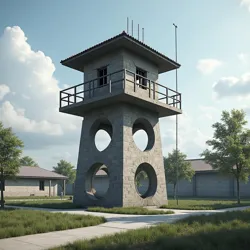Atlanta Reeducation System (2032-2036)
 Remains of the Piedmont Processing Center, the largest reeducation facility in the Atlanta system, photographed in 2045
Remains of the Piedmont Processing Center, the largest reeducation facility in the Atlanta system, photographed in 2045The Atlanta Reeducation System was a network of detention and indoctrination facilities operated by the Liberty States Alliance during the Second American Civil War. Established in 2032 under the pretense of "national purification," these facilities were responsible for the detention, torture, and attempted ideological conversion of an estimated 400,000 Americans deemed "politically unreliable" by the Atlanta-based government. The system's brutal practices and high mortality rate became a significant factor in escalating the civil conflict and drew widespread international condemnation.
Origins and Establishment
The system emerged from the Constitutional Crisis of 2029 when the southeastern states, under the leadership of the newly formed Liberty States Alliance, began detaining individuals they accused of "liberal-socialist infiltration." The Atlanta Preservation Act of 2032, drafted by hardline LSA ideologist Marcus Thaddeus Reynolds, provided the legal framework for what would become one of the war's most notorious institutional atrocities.
Initially presented to the public as "civic reorientation centers," the facilities quickly evolved into a vast network of forced labor and ideological reprogramming camps. The system was heavily influenced by historical examples of political repression, but incorporated modern surveillance technology and psychological manipulation techniques developed by the Department of Cultural Integrity, a newly created LSA agency.
Facility Network and Operations
 A typical guard tower at the Marietta Processing Facility, showing the distinctive "cross and stars" insignia of the Cultural Integrity Forces
A typical guard tower at the Marietta Processing Facility, showing the distinctive "cross and stars" insignia of the Cultural Integrity ForcesThe Atlanta Reeducation System consisted of 27 major facilities and numerous smaller satellite camps spread across LSA territory. The largest facilities were the Piedmont Processing Center near Atlanta, which held up to 50,000 detainees, and the Chattanooga Reorientation Complex, notorious for its experimental behavior modification programs.
Detainees were classified into three categories: "Redeemable" (political moderates and conservative Democrats), "High-Risk" (progressive activists and intellectual figures), and "Irredeemable" (civil rights leaders, LGBTQ+ advocates, and socialist organizers). This classification system determined the severity of treatment and the likelihood of release.
The facilities employed a combination of forced labor, psychological manipulation, and physical coercion. Detainees were required to participate in "American Values Restoration" sessions, which combined religious indoctrination, historical revisionism, and anti-liberal propaganda. The Displacement Crisis of 2034-2037 was partially triggered by people fleeing potential internment in these facilities.
Methods and Conditions
The camps employed various methods of control and "reformation," including sleep deprivation, stress positions, and a point-based privilege system that pitted detainees against each other. The Barnes Protocols, developed by Anastasia Barnes, established standardized procedures for breaking down and reconstructing detainees' political identities.
Forced labor was a central component of the system, with detainees required to work in manufacturing facilities producing military supplies for LSA forces. The work conditions were deliberately harsh, with inadequate food, minimal medical care, and exposure to hazardous materials. Mortality rates in some facilities reached 30% annually due to combinations of malnutrition, disease, and physical abuse.
International Response and Investigation
Evidence of the camps' existence began reaching international observers in late 2033, prompting widespread condemnation and calls for intervention. The UN Emergency Response Protocol specifically cited the Atlanta Reeducation System as a primary justification for humanitarian intervention in the American conflict.
Canadian and Mexican intelligence services played crucial roles in documenting the system's operations, with their findings contributing to the post-war Atlanta Trials of 2039-2042. The European Union's comprehensive report, "The Architecture of Ideological Cleansing," provided detailed analysis of the system's organizational structure and methods.
Legacy and Memorial
Following the war's end, the sites of major facilities were preserved as memorial museums under the National Reconciliation Program. The Piedmont Processing Center Memorial has become a significant site for studying political repression and civil rights violations, while the Atlanta Museum of Human Rights, established in 2043, maintains extensive documentation of survivor testimonies.
The system's impact on American society continues to influence political discourse and civil rights legislation. The Institutional Safeguards Act of 2041 specifically prohibited the establishment of political detention facilities and mandated strict oversight of all government detention centers.
See also
- Liberty States Alliance Atrocities
- Post-War Justice Trials
- Cultural Integrity Forces
- Survivors of Atlanta Network
- American Refugee Crisis Documentation Project
References
The article draws from extensive documentation compiled by the Truth and Reconciliation Commission (2039-2044), survivor testimonies, and international observer reports. Key sources include the comprehensive "Atlanta System Archive" maintained by the National Archives and the International Criminal Court's investigation files.